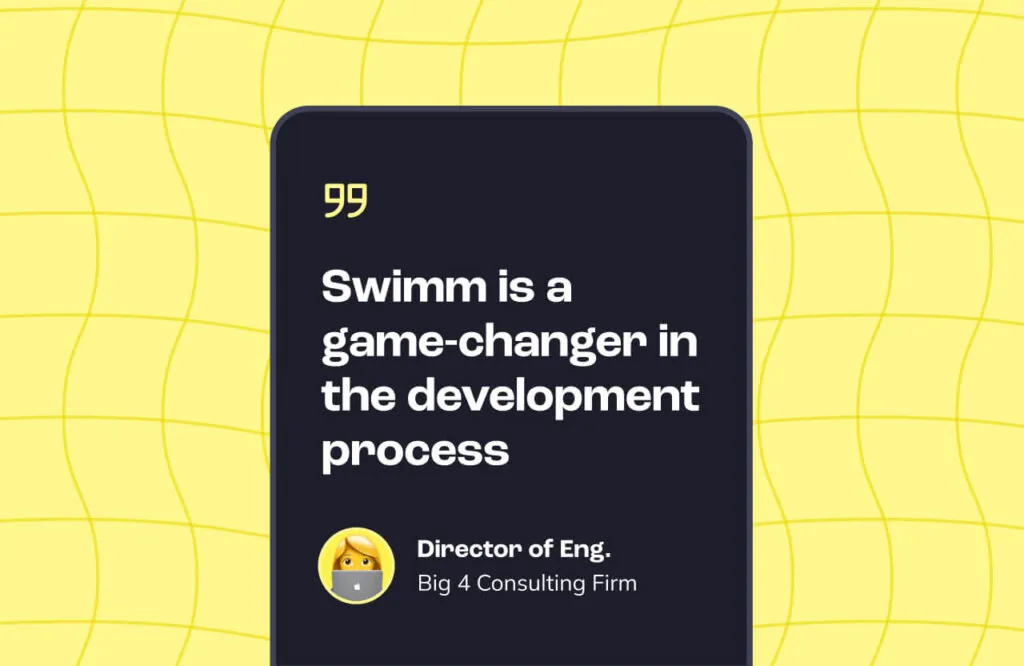For TechBio organizations like Recursion, making technical knowledge and documentation accessible to everyone is not just a nice to have — it’s a necessity.
With over 1,000 active repositories and a team of 200+ developers, Recursion’s approach to drug discovery sits at the intersection of engineering, data science, biology, and computational chemistry. This presents challenges in maintaining documentation that is accurate, up-to-date, and easily discoverable for their growing, interdisciplinary team.
The problem →
We reached a point where we assumed documentation either didn’t exist or was unreliable. Employees relied on Slack for explanations, wasting time and causing us to lose momentum. We often reimplemented the same solutions and faced recurring problems due to poor documentation.
AJ Williams, Associate Director of Engineering
Before Swimm, Recursion experimented with a number of different documentation tools, but they all failed. The problem was twofold: there wasn’t enough documentation, and what existed couldn’t be trusted.
AJ Williams, Associate Director of Engineering at Recursion, explained: “We thought just buying a tool would be enough, but we soon realized that documentation is more of a people problem than a technical one. If you can turn it into a technical problem, you’re on the right track to fixing it.”
Since Recursion had over 1,000 active repositories, the issue was even more challenging. The documentation was scattered and unreliable, leading to repeated mistakes and wasted time. Despite using various tools like Guru, Kipwise, and Google Docs, Recursion couldn’t keep their documentation organized, discoverable, or up to date.
The solution →
Anytime you can turn a cultural problem into a technical one, you’re on the right track—technical problems are much easier to solve. That’s exactly what Swimm has done for us. It transformed the challenge of getting busy, overworked developers to take on more work into something easy and natural for them to do.
AJ Williams, Associate Director of Engineering
After an initial trial, Recursion quickly implemented Swimm across their organization. The standout feature for Recursion was Swimm’s ability to link documentation directly to code changes. This ensured that documentation was always up-to-date—whenever the code was updated, the related documentation was automatically updated too. This kept everything in sync and prevented confusion.
With over 200 developers, a lot of repositories, and an interdisciplinary team that depends on accurate documentation, connecting code to documentation turned a cultural challenge into a manageable technical task. This made it easier for developers to keep documentation accurate without added effort.
Recursion had already built tools to help their teams quickly start new projects. When they adopted Swimm, they integrated it into these tools, making documentation a key part of every new project from the beginning. This approach encouraged developers to create Swimm docs from the start, leading to widespread adoption across the team.
The results →
Teams using Swimm have a significant advantage over those that don’t. For the latter, maintaining and updating documentation is a significant burden, risking its decline in usability. They have to routinely check and update documentation, treating it as a core part of every feature they work on.
AJ Williams, Associate Director of Engineering
For Recursion, adopting Swimm significantly improved how the entire organization transfers technical knowledge and manages documentation, turning a major pain point into a manageable task. By linking documentation directly to code changes, Swimm ensured that documentation was always up-to-date and trustworthy. AJ explained, “The core feature of Swimm—binding documentation to code—is the killer feature for us.”
AJ and the developers at Recursion report that Swimm completely automated the documentation maintenance process, keeping everything in sync with ongoing code changes. This led to fewer mistakes, less time spent on redundant tasks, and more time that could be devoted to development.



